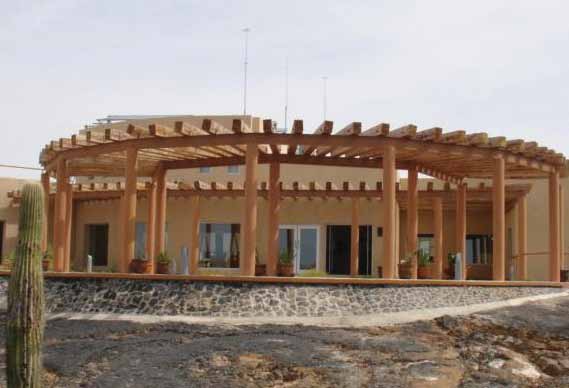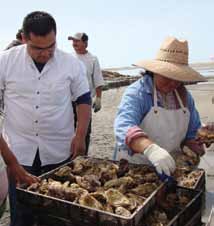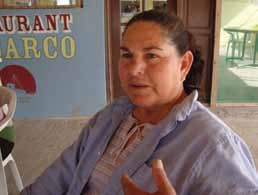Contents | 3 | 4 | 5 | 6 | 7 | 8 | 9 | 10 | 11 | 12 En español
Activities for conservation of Morúa Estuary
in Puerto Peñasco, Sonora
María Isabel Cervantes Rivas, President |
With help from CEDO ((Intercultural Center for Desert and Ocean Studies, in English), the ecology group “Los que quiseiran ser más” (Those who would like to be more) began negotiations to undertake conservation activities in the Morúa Estero.
|
The students speak of being very excited about beginning talks with María Isabel Cervantes Rivas, president of the Ostrícola Única de Mujeres Oyster Cooperative that works within the estuary.
The negotiations come from the need to combat the primary sources of contamination in the estuary.
Estuaries are wetlands that provide an abundant food source for the organisms that live in them. They are ideal sites for reproduction and growth of many species, including oysters. Conservation of the estuary is vital for oyster farming, which is of great economic importance to the community.
Chacón Villa states that the negotiations led to a trash cleanup in the esturary on April 3, 2010. The cleanup resulted in the collection of 533 pieces of garbage. Of these, 54.3% were pieces of polystyrene foam, with much of this material originating from the flotation systems that are used by all of the oyster farms in the port.
As a result of this collection and analysis of the garbage found, the design of ecological flotation devices for oyster farming are being considered, as is the discontinuation of the current devices. Additionally, the group has formally requested the help of Puerto Peñasco’s City Hall in order to conserve Morúa estuary.
Students from CETMar No. 14 (Center for Marine Technology Studies)
Prototype Visitor’s Center Springs up in Sonoran Desert
By Gerardo Manuel Pasos González*
One of Mexico’s Thirteen wonders, the Pinacate and Gran Desierto de Altar Biosphere Reserve will soon be declared a World Heritage Site.
Cradle of the Santiaguito and Tohono O’odham cultures, the area is rich indigenous history, rituals and activities that are valuable because they offer an interpretation of life as it relates to nature.
Boasting four hundred natural geological formations, among these craters, fossilized magma and lava mountains, the reserve’s protected area is comprised of almost 1,765,706 acres of the most biodiverse desert in the world. It also has the largest sand dunes in North America that reach to over 650 feet high.
Living in this unique landscape are species characteristic of the area, including the desert pup fish, gray fox, red-tail hawk, cacti and mesquite.
The concept of the Thirteen Wonders of Mexico comes from a national survey conducted by the television industry. Now, on the eve of the international declaration by UNESCO, Conanp (the National Commission of Protected Natural Areas) and the Sonora State Commission for the Promotion of Tourism have created a prototype for a nationwide visitor’s center. Schuk Toak (Sacred Mountain) has seen an investment of about USD $2.8 million which is being channeled into the highest level of technology available for natural resource conservation, all with the aim of creating the largest self-sufficient public building in Mexico.
Designed by specialists from the Autonomous University of Baja California (UABC) who have taken advantage of the landscape's natural features, Schuk Toak sits on 4265 square feet of lava flow.
Energy wise, it is independent of the conventional electrical grid. One hundred percent of its electricity comes from renewable sources. It is an example of the feasibility of clean energy use which produces no carbon dioxide (CO2), a contributor to the greenhouse effect and climate change that affects survival of all species on the planet.
It is oriented on the land to take advantage of natural ventilation. It was constructed of special materials and high-tech methods that have provided an exponential savings of energy. These materials are durable, low maintenance, non-toxic, have a low energy footprint and include certified wood. The structure also has more than 980 square feet of solar panels that are enough to supply the electrical requirements of the center.

Schuk Toak will also form part of the seismic network of northwest Mexico with the upcoming installation of its new seismograph.
*Student at the Advanced Institute of Tecnology (ITSPP), Puerto Peñasco
Journalism to Raise Environmental Awareness

